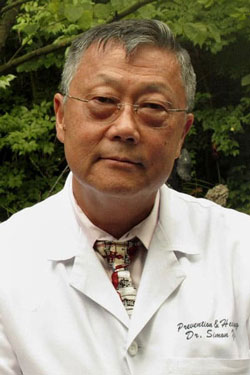
By Simon Yu MD
Ehlers-Danlos syndrome (EDS) was first described over 100 years ago and is now recognized more often with many subgroups of classification. EDS is considered genetic-related hereditary connective-tissue disorder. Common symptoms include hypermobile loose joints, joint pain, stretchy velvety skin, and is associated with cardio-vascular problems including aortic dissection, joint subluxation and dislocation, scoliosis, chronic pain, and a multitude of growing list of symptoms. Is it possible that EDS is the final manifestation of reprogrammed host DNA or epigenome by bacterial pathogens? By the way, Hippocrates described “excessive mobility” in 400 B.C and hypermobile joints are old news, but naming Ehlers-Danlos syndrome (EDS) is new.
Recently I saw a young woman with vague chest pain and hypermobile joints. She was told she had cardiovascular related Ehlers-Danlos syndrome (EDS) by an EDS specialist from the east coast. My evaluation indicated she has hidden dental infections in old wisdom teeth extraction sites based on acupuncture meridian assessment (AMA) that was affecting her vague chest pain. Her dental X-rays were normal. I sent her to an oral surgeon to clean out the old infected dental jaw socket areas and her vague chest pain was resolved. I also sent her to see a rheumatologist for a second opinion for EDS and the rheumatologist told her she did not have EDS. This case makes you think about over diagnosing Ehlers-Danlos syndrome, possibly from mimicking EDS-like symptoms from other factors.
I began to explore the connections between hidden dental infections and EDS with limited information. EDS may make you more susceptible to periodontal infection, but not the other way around. Periodontal involvement may lead to the diagnosis of underlying systemic EDS condition, but there is no literature supporting that dental-periodontal infection might be the culprit of EDS. Is it possible that some unrecognized infections may trigger genetic expressions and we assume that the EDS is solely a genetic inherited disorder?
I came across a 2014 article by Silmon and Kim in The American Journal of Pathology titled, Pathogens Hijack the Epigenome: A New Twist on Host-Pathogen Interactions. They state, “Pathogens have evolved strategies to promote their survival by dramatically modifying the transcriptional profile and protein content of the host cell they infect.” A 2018 case report by Mozayeni et al. in Medicine indicated systemic Bartonella infection associated joint hypermobility mimicking EDS, type III and to consider systemic bartonellosis as a differential diagnosis for EDS. Pathogens are a part of biohacking of epigenomes that we are beginning to accept with some limited understanding.
Treat the underlying infections and it might modify the expression of epigenomes and stop the biohacking. For me, a treatment plan is based on acupuncture meridian assessment (AMA) and balancing the meridians, not based on medical diagnosis. For EDS, Lyme, or chronically ill patients, hidden dental infections and parasites are the most often neglected medical conundrum. You can read the full version of this on the articles page on my website, www.preventionandhealing.com.
Dr. Simon Yu, MD is a Board Certified Internist. He practices Internal Medicine with an emphasis on Integrative Medicine to use the best each has to offer. For more articles and information about integrative medicine, patient success stories, and Dr. Yu’s latest book, AcciDental Blow Up in Medicine: Battle Plan for Your Life, visit his website at www.preventionandhealing.com or call Prevention and Healing, Inc., 314-432-7802. You can also attend a free monthly presentation and discussion on Integrative Medicine at his office on the second Tuesday each month at 6:30 pm. Call to verify the date. Seating is limited, arrive early.
Simon Yu, MD
Prevention and Healing, Inc.
10908 Schuetz Road
St. Louis, MO 63146 314-432-7802
www.preventionandhealing.com
Weaving Internal Medicine with Integrative Medicine to Use the Best Each Has to Offer


